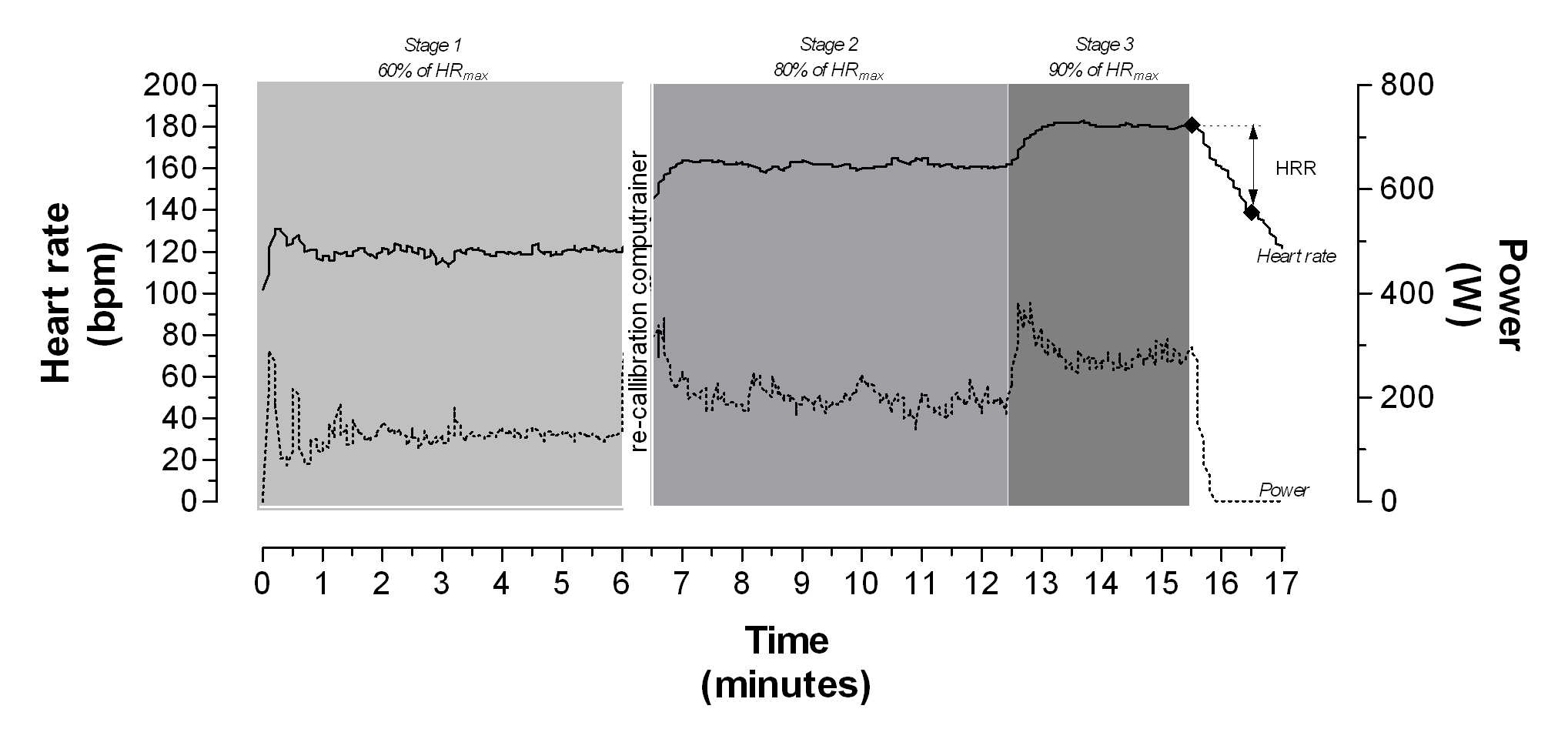Basic principles on how to perform the LSCT
Background
The LSCT is a submaximal cycle test, which for now, has to be performed under controlled environmental conditions (18-22°C and 50-60% relative humidity) to assure accurate predictions of performance and being able to monitor fatigue levels over time. It is therefore recommended to perform the LSCT on an indoor trainer at a set time and day of the week (e.g. Wednesdays). As the LSCT is preformed at fixed submaximal heart rate subjects should:
- not consume caffeine 3 hours before the test
- do not talk during the test and during the heart rate recovery (HRR) period
- sit straight up and stop cycling during the HRR period
- minimize confounding factors (distraction factors - such as other cyclists taking to you while you are performing the LSCT)
LSCT
The total duration of the LSCT is 17 minutes, during which time subjects are asked to cycle at intensities which elicit target heart rates of 60% (stage 1), 80% (stage 2) and 90% (stage 3) of their maximum heart rate (HRmax) Target heart rates for each of the different stages of the LSCT are calculated based heart rate maximum, which preferably need to be established during a Peak Power Output test (PPO) or a VO2max test (Lamberts et al. 2009). After the calibration of the ergometer subjects should change their front derailleur to the ‘small’ chain ring, after which the LSCT can be started.

Figure 1. Graphical representation of LSCT
During the LSCT, subjects are allowed to change their gear ratio on the rear derailleur to match the exercise intensity with the targeted heart rate. During the first stage (60% HRmax) subjects should aim to keep their heart rate within (± 2 beats·min‑1) of the target heart rate (e.g. 150 – between 148 and 152). After stage 1 (0.00 - 6.00 min), subjects are asked to change their front derailleur to the ‘large’ chain ring and ergometer can possibly be re-calibrated during a 30 seconds period (6.00 – 6.30). During stage 2 and 3, subjects are allowed again to adjust their gear ratio at the rear derailleur while the front derailleur will remain on the ‘large chain’ ring. Within stage 2 (6.30-12.30) subjects are asked to target 80% of HRmax, while subjects during stage 3 (12.30-15.30) are asked to target 90% of HRmax. Heart rate during stage 2 and 3 should be kept within 1 beat of the target heart rate (e.g. 174 – between 173 and 175). If the target heart rate in stage 3 cannot be reached wihtin 1 minute, cyclists should complete stage at an RPE level that they normally expirience during stage 3. For example if a cyclists normally tends to experience a RPE level of 17, the cyclist should aim to ride stage 3 at an RPE at 17... even if this means her HR and Power Output are lower. However in this senario changes in HRR should be interpreted with more care.
Directly after stage 3 (15.30) subjects are asked to stop cycling and sit straight up, so that HRR data could be captured over the final 90 second (15.30-17.00). Rating of perceived exertions between 6 and 20 (see Figure 2) should be given at 5.00 for stage 1, at 12.00 for stage 2 and at 15.00 for stage 3.
6 7 Very, Very Light 8 9 Very light 10 11 Fairly light 12 13 Somewhat Hard 14 15 Hard 16 17 Very Hard 18 19 Very, very Hard 20 |
Figure 2. 6-20 Borg Scale (Borg GA, MSSE, 1982)
